How Fillers Lift the Face
(Filler Placement Technique and the Ideal Candidate)
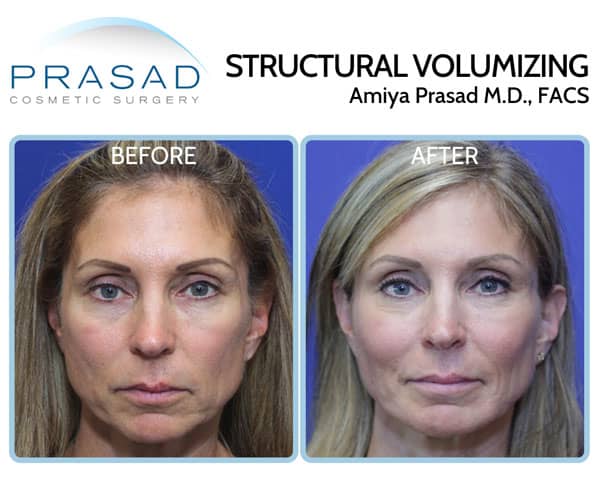
Facial aging affects all of us, and people understandably want to look their best when facing aging changes. There are two basic parts of facial aging: volume loss, which is the diminishment of bone, muscle, fat, skin thickness, and soft tissue as we get older; and skin and tissue laxity, which leads to a sagging appearance in advanced facial aging.
Facial fillers are often used to enhance and augment facial volume loss, which occurs before significant skin and soft tissue sagging. Naturally, people ask if fillers can also lift the skin while enhancing volume. I’ll discuss what cosmetic fillers can do to improve facial appearance, and whether they can help lift sagging skin.
My Experience with Cosmetic Procedures
I perform various types of facial cosmetic surgery, including facelift approaches, upper and lower eyelid surgery, facial implants, brow lifts, and neck lifts.
I also perform filler treatments for the cheeks, chin, jawline, upper and lower eyelids, forehead, and even ears and nose. My experience with surgical facelifts, and facial implant surgery allows me to place cosmetic fillers differently, often at the bone level for better definition, more natural results, and more stable outcomes, which I call Structural Volumizing.
Understanding Facial Aging
Facial aging follows a certain chronology of issues. Collagen, which gives skin its strength, begins to decline by 1% a year after age 25. Facial volume loss starts gradually, but becomes noticeable in the mid to late 30s and 40s. Skin and tissue laxity become more pronounced in the 50s. Often, skin appears to sag earlier than expected due to volume loss, especially from bone which reduces the framework supporting the skin.
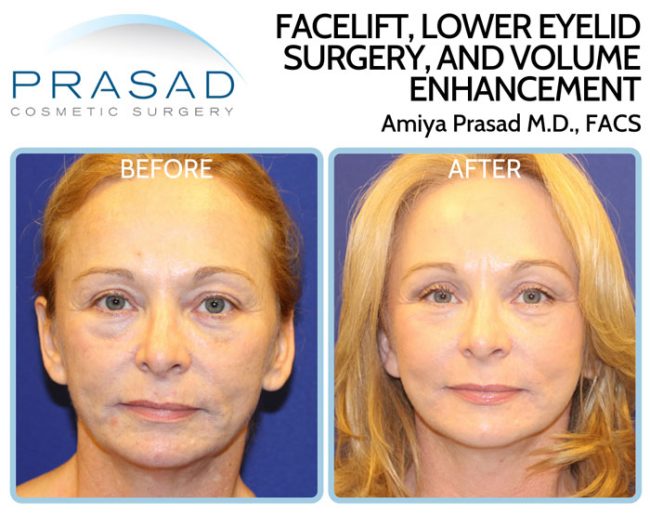

As facial volume loss progresses and becomes more noticeable in the 40s. Significant skin and soft tissue laxity is the last part of facial aging, which becomes more significant in the 50s and older.
At this point, many are wondering why skin laxity seems to be a big issue even before age 50, and it’s already noticeable perhaps in the 30s or 40s. The reason the skin appears to sag earlier than the 50s is facial volume loss.
With facial volume loss, the framework supporting the face diminishes, mainly from bone volume loss. With the structured framework diminishing, there is reduced support to hold up the overlying skin, so the skin appears to be sagging, even if the skin is not significantly lax or descending.
Can Fillers Lift Sagging Skin?
Yes, in cases where skin is not yet significantly sagging but facial volume loss is reducing facial skin support, fillers can help lift sagging skin. People in their late 30s to early 50s may experience more volume loss than significant skin sagging. By adding volume, we provide structural support to the skin, creating a lifting effect, although the goal is to support rather than directly lift the skin.
However, not all filler treatments add structure to the face. Some patients end up with a soft and doughy appearance, often referred to as “pillowface.” This happens because conventional filler is placed too close to the skin’s surface, where it migrates and lacks structural support.
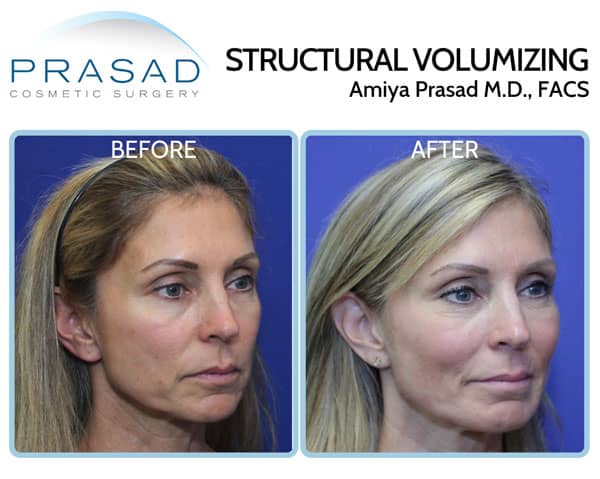
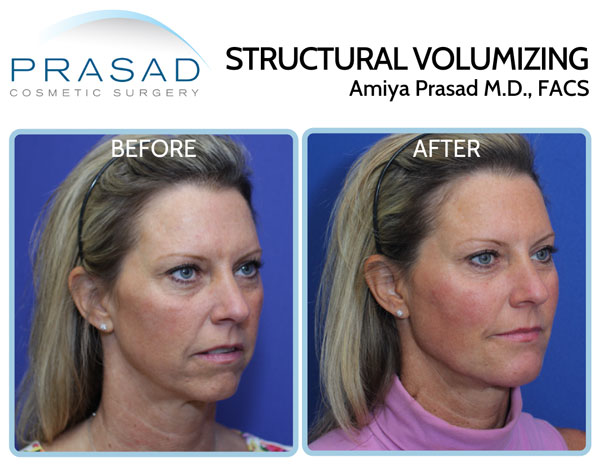
The Structural Volumizing Technique
To add a structured and defined look in filler placement, what I do in my practice is add filler at the deeper bone level. This technique, which we call Structural Volumizing, places filler much deeper than conventional filler placement. Facial structure is primarily made up of bone structure, and facial volume loss occurs mostly from bone loss. Facial volume loss is particularly noticeable in the cheeks, as they are a dominant feature when we directly look at ourselves or look at others. The once rounded cheeks we all had when we were younger now look flat, and hollow with no projection.
With this technique, we are adding volume to the bone, using thicker hyaluronic acid fillers like Juvederm Ultra Plus, and Juvederm Voluma. Thicker fillers can be used in facial areas with little to no movement, such as the cheeks, jawline, and chin.
When placed at the bone level, these fillers are held in place by the overlying muscle, to prevent the filler from migrating, and looking soft and rounded. With Structural Volumizing, results look defined, solidly structured, and angular. Our patients look natural, with their facial features enhanced so they look like themselves, but younger with a fuller face. Conventional filler treatment cannot achieve the same result.
Treating Jowls with Filler (Fillers to Lift the Lower Face)
Some facial areas that people normally associate with surgical lifting can be treated with filler. For example, jowls at the jawline are often thought of to require a facelift. The appearance of jowls can be due to hollowing of a point on the jawbone called the mandibular notch. Hollowing of the mandibular notch causes the jawline to become discontinuous, and appear like sagging jowls.
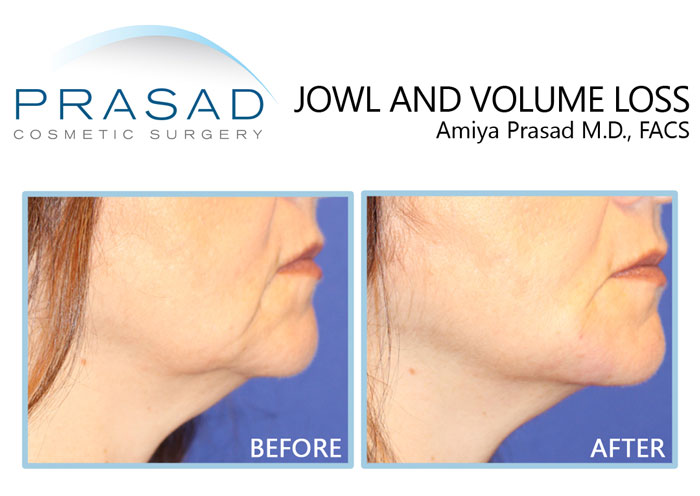
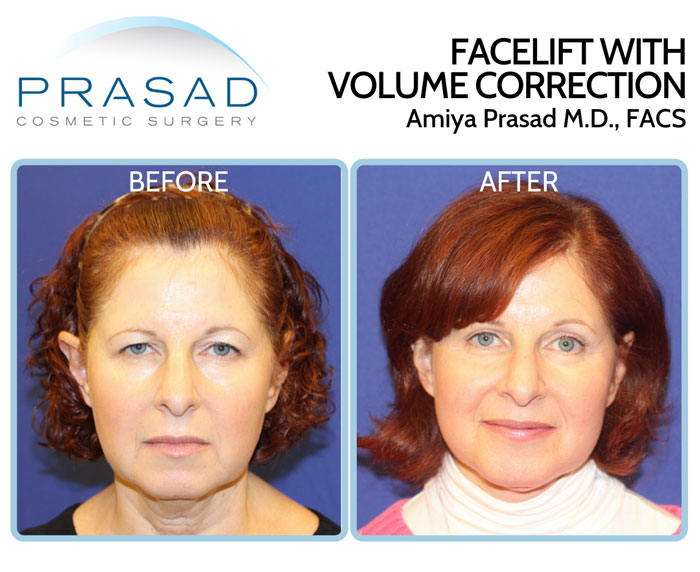
By filling the mandibular notch directly with filler, which is held in place by the masseter muscle to prevent migration, some cases of jowls can be treated only with filler for a continuous jawline.
Applying filler at the bone level of the chin can also further enhance the jaw angle, for a more defined and youthful appearance.
Fillers vs. Surgical Facelifts
With Structural Volumizing, the effects on the face can appear like the results of a facelift. However, this doesn’t mean that filler can replace a surgical facelift. As stated earlier, significant facial volume loss occurs at a younger age than significant skin laxity. Therefore, people in their late 30s, 40s, and even some in their 50s can get great results with just facial filler treatment, but in more advanced aging, fillers cannot provide enough structural lift on their own to raise sagging skin, reposition soft tissue, and tighten the underlying muscle of the face called the SMAS, or the superficial musculo aponeurotic system.
The Structural Volumizing Procedure
The Structural Volumizing procedure is done in an exam room using local anesthesia and topical anesthesia for the patient’s comfort. I place thicker hyaluronic acid fillers like Juvederm Ultra Plus, and Juvederm Voluma using blunt-tipped cannulas instead of needles. Blunt cannulas are designed to glide through the internal anatomy, so they have less chance of hitting a blood vessel, reducing the risk of injury or complications.
While the Structural Volumizing (The Y Lift®) procedure involves no surgery, the surgical knowledge of performing facelifts is needed in navigating the internal anatomy, and placing filler through the muscle layer, and into the bone level.
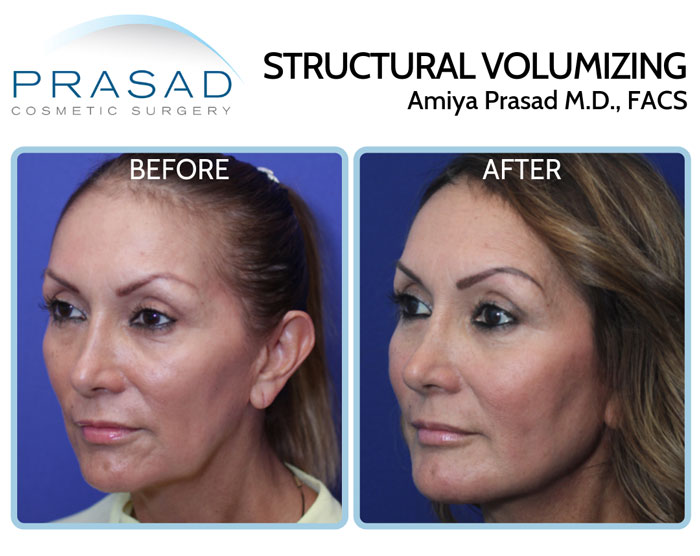
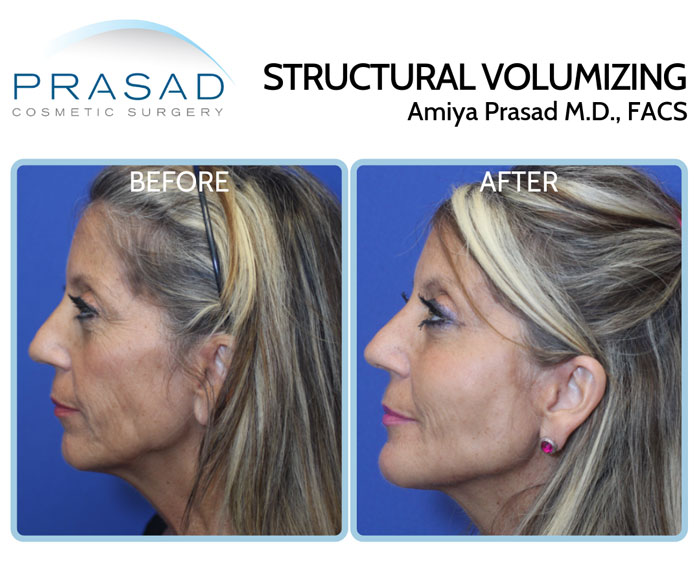
Some doctors believe they have reached the bone level with a needle or cannula when they hit a hard surface, but actually need to go beyond that space for bone level placement. The placement of filler takes minutes, and patients can see their results right after treatment. There is no actual recovery time as patients can actually go back to work right after the treatment, making it a true lunchtime procedure. However, there may be some temporary swelling from the trauma of the cannulas entering the skin, but this tends to resolve rather quickly. Temporary bruising is a possibility, but it is avoided in many patients. Depending on the thickness of the filler, as well as individual metabolism, results can last 1-2 years.
Age-related volume loss reduces facial structure earlier than skin laxity. By rebuilding this structure with filler at the bone level, we can support the skin and create a lifting effect. However, in advanced aging, volume enhancement alone is insufficient, and surgical lifting becomes necessary to tighten the skin, muscles, and soft tissue for comprehensive rejuvenation. I hope you found this information helpful.
MedSpa (Medical Spa) in Manhattan, New York City and Long Island, New York
Dr. Amiya Prasad is a Board-certified cosmetic surgeon, and a Fellowship-trained oculofacial plastic and reconstructive surgeon. He’s been in practice in Manhattan and Long Island for over 25 years.
To schedule an appointment fill up the contact form below or call any of our offices at (212) 265-8877 for Manhattan, New York City; (516) 742-4636 Garden City, Long Island; or (703) 356-1336 for Vienna, Virginia.

